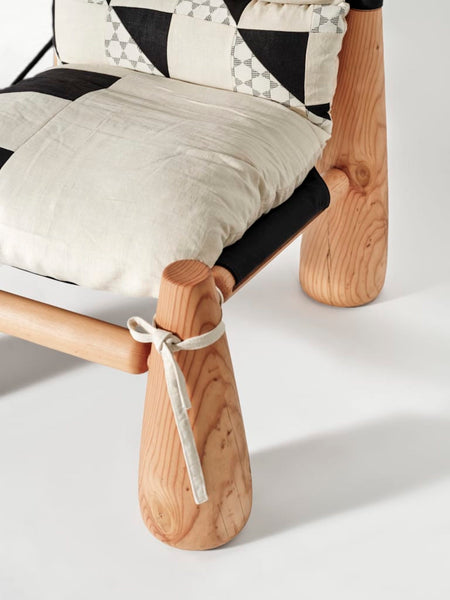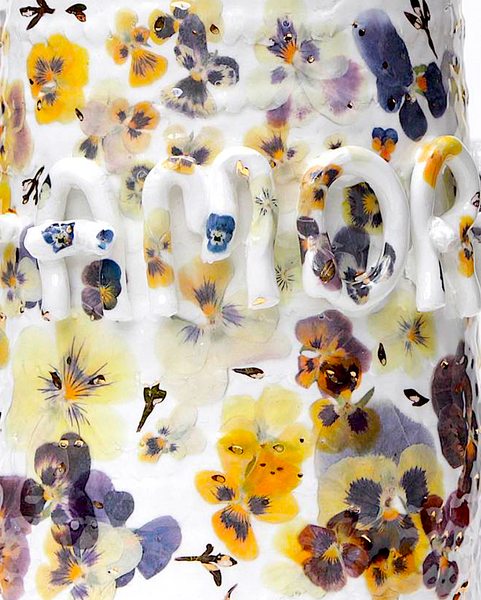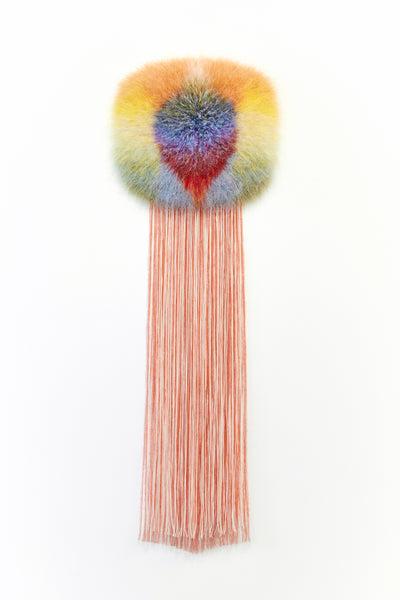Curriculum Vitae
Creative Vision
Galerie kreo founders Clémence and Didier Krzentowski on the paths that led them to design, the importance of creating space for experimentation, and their latest presentation at Design Miami/Basel.
As one of the most esteemed design galleries in the world, over the past two decades, Galerie kreo has positioned itself as a space for world class contemporary designers to experiment and expand their practices. From its gorgeous locations in both Paris and London, kreo consistently collaborates with standard bearers of contemporary design—including the likes of Ronan and Erwan Bouroullec, Hella Jongerius, Jaime Hayon, Konstantin Grcic, and many more—while also specializing in exceptional Italian and French lighting from the 1940s to the 1980s.
As the gallery approaches its 25th anniversary, we sat down with founders Clémence and Didier Krzentowski to learn more about their creative paths and passions as well as their upcoming projects—including kreo’s latest presentation at Design Miami/ Basel and a new fall show honoring the late Virgil Abloh.

Where did you each grow up, and what first sparked your passions for design and art?
Clémence: I grew up in Paris, and as a young girl, I was very passionate about literature and dance. Art and design came into my life later, quite naturally. My first ‘real’ job with the Olympic Games of Albertville in 1992, as part of the Organisational Committee. It was also my first significant involvement with design, as I enlisted French designer Philippe Starck to design the Olympic torch. We still keep one of the torches at home, amongst all the design pieces we later collected and produced with the gallery…
Didier: I also grew up in Paris. We had family friends who had an incredible art collection, and they introduced me to art at a young age. I have always been a collector at heart, starting with stamps, then watches, photography, and eventually conceptual art. Along the way, I developed a strong interest in Italian lamps from the 1950s to the 1980s. This passion has stayed with me for over forty years, and I have assembled the largest collection of lamps from that period. We also showcase some of these lamps at the gallery.
When, where, and how did you two meet?
Clémence: We met in 1988, through mutual friends on a golf course…
Didier: Although she was much better than I was!

What was the catalyst for launching the gallery in 1999? And what was your vision?
C&D: Initially, kreo started as an agency representing industrial designers. We collaborated with designers on projects with brands and cities. When galleries began opening in Paris’s 13th district in the 1990s—in a way similar to New York’s Soho district in the 1980s—we were presented with the opportunity to open a small gallery space. We had been thinking about producing limited edition pieces with the designers we were already working with, and this seemed like an optimal opportunity to start.
How has your vision evolved over time?
C&D: The original vision was to create a design laboratory—a space where designers could present projects that were new, different, and went beyond what was possible in the industrial field. The creative process had to be completely free, allowing for experimentation. We would then produce the pieces. Early on, we were lucky enough to meet collectors who connected deeply with the work we were doing; this allowed us to maintain the same vision throughout the gallery’s history, sometimes producing very radical pieces.
Tell us a bit more about the design laboratory approach.
C&D: When we refer to our gallery as a research laboratory for design, we mean that it provides a space for the designers we collaborate with to create furniture with no constraints. This free space usually allows room for experimentation—and this experimentation can take many forms, or materialize through a number of creative angles. Some collections push the boundaries of specific materials, while others explore new forms or challenge established typologies. The gallery becomes a platform for designers to explore and express their creativity.

How do you choose the designers with whom you work?
C&D: The designers we work with are first and foremost industrial designers, working in a field where objects are often produced on a large scale. However, when they propose projects to us and we work on them together, these projects undergo a different process. They are conceptualized, tested, and produced over an extended period, often resulting in small editions of just 12 pieces. This unique approach can serve as a sort of ‘respite’ from their regular work, which is often bound by feedback chains, time limitations, and budget constraints.
Our hope and expectation is that the projects proposed to us reflect this freedom and ingenuity: the objects should feel like objects you wouldn’t typically encounter, that might provoke thought, or evoke a strong impression of meticulous research and exceptional craftsmanship. Ultimately, the resulting pieces showcase a focus on the highest quality materials and thoughtful form.
We understand next year marks the gallery’s 25th anniversary. Congratulations! What are you most proud of in your work to date?
C&D: Thank you! Looking back at the past 25 years, we can honestly say that every single collection we’ve produced has filled us with tremendous pride. It’s challenging to single out just one or even a few of them.
However, our thematic shows hold a special place in our hearts. Our recent ‘ladder’ show, for example, featured ladders designed by all the designers we collaborate with. Each piece was remarkably different, showcasing each designer's unique interpretation of what a ladder can be. This was our fourth typological show since the start of the gallery, with previous shows focusing on necklaces, stools, and mirrors. What’s also exciting about these shows is that the designers are eager to see what the others have made: it is like a collective exercise.

How has the market for collectible design developed over the past two decades?
C&D: The market for design has experienced significant growth and transformation over the past two decades. While there was already a market for vintage design spanning various periods, the interest in late 20th-century and contemporary creations has surged! One exciting development is the growing appreciation for the fusion of old and new—which we think is fantastic. It is also wonderful to be able to collect something that you can interact with on a daily basis—actually using that chair, or that table. We think this is a notion that is now more commonly understood and valued, as collectors increasingly appreciate the dialogue and coherence between art and furniture design in their private spaces.
How would you like to see Galerie kreo continue to develop over the next 25 years?
C&D: Looking ahead, we aim to maintain our commitment to showcasing designers who push boundaries and challenge traditional notions of design. We also strive to foster collaborations and partnerships that continue to expand the reach and impact of collectible design.
Can you spotlight a few of your favorite pieces from your collection and walk us through what you love about them?
C&D: We are happy to be showcasing some very new pieces in our booth at Design Miami/ Basel this year. One standout piece is Konstantin Grcic’s LF2 lamp, hailing from his latest show currently on view in Paris called TRANSFORMERS. This floor lamp resembles a micro-architecture with parallel geometries, featuring twenty LED spotlights and a motion sensor for on and off control. The LF2 beautifully exemplifies Konstantin's unwavering commitment to radical materiality and form exploration, crafted from two simple materials, aluminum and light. Next to it there’s also an earlier work by Konstantin: his minimal carbon chaise longue. We’ve also brought a black console-shelf by Marc Newson from his latest collection, Quobus, in thickly enameled steel, and a black bas-relief by Ronan Bouroullec, which is a never-before-seen color from this body of work. And we also have some beautiful vintage pieces, including the centerpiece pendant by Gino Sarfatti, elegantly spiraling down.

How would you describe your working relationship? Is there a particular division of labor?
Didier: I often joke that Clémence does all the work while I take naps.
Clémence: (laughs) But of course that’s not true! I do work in a more traditional sense—I am always physically at the gallery, overseeing operations, collaborating with the team, managing production, meeting with clients … But Didier’s passion lives inside him and is there always— so he naturally tells the stories of the pieces, speaks with the designers every day. And he sources the vintage pieces, which is a whole activity in itself.
What is the best thing about working together?
C&D: Sharing the same passion, and having the gallery be a part of our family. Our daughter Clara joined the gallery as London Director two years ago—and she grew up with the gallery, with the designers, knowing all the pieces. It’s a beautiful thing to share all of this together.
What’s your best piece of advice for young collectors just starting out today?
Clémence: My best piece of advice may sound cliché, but it holds true: collect what you love! Follow your instincts and choose pieces that truly inspire you. Living with objects that have deeply resonated with you will continue to bring inspiration and joy into your life.
Beyond your own projects, what is exciting you most in the design world right now?
C&D: Certainly the development of new materials, especially sustainable, recycled materials that give a second life to unused items; they will for sure inspire our designers in new ways.

What’s up next for you? Any particular upcoming shows or projects you can share?
C&D: Following Konstantin's exhibition, we have an exciting show planned for the fall in honor of Virgil Abloh. Virgil was someone who introduced a new breath to the gallery, with his first show, EFFLORESCENCE, in 2019. One striking statement he made during that exhibition was, ‘Writing is the color of the 21st century.’ By this statement, he referred to the prevalence of graffiti, branding, and the ubiquitous use of written elements in our surrounding products. Virgil saw writing as a solid color, representing the essence of our time. Our upcoming show pays homage to this concept, exploring its origins in 1980s New York culture and the lasting cultural legacy it holds today, which Virgil played an important part in perpetuating.
Thank you so much, Clémence and Didier!
Galerie kreo’s latest presentation for Design Miami/ Basel is on view June 13-18th at Booth G01 at Messe Platz, and features contemporary works by the likes of Virgil Abloh, Hella Jongerius, Front, Marc Newsom, and Ronan Bouroullec, among others, as well as exceptional vintage lighting and pieces by A.R.P., Robert Mathieu and Gino Sarfatti.
The gallery’s latest exhibition, Konstantin Grcic: TRANSFORMERS, is on view now at the gallery in Paris.



